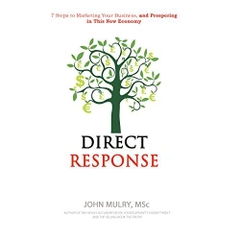-
-
-
Tổng tiền thanh toán:
-
-
Thông tin
-
Tìm sách theo yêu cầu
Book Description
Publication Date: October 4, 2011
In DEMAND: Giving People What They Love Before They Know They Want It (Crown Business; October 2011), Adrian Slywotzky, named by Industry Weekone of the world’s six most influential management thinkers, provides a radically new way to think about demand, with a big idea and a host of practical applications—not just for people in business but also for social activists, governments leaders, non-profit managers, and other would-be innovators.
They all need to master such ground-breaking concepts as the hassle map (and the secrets of fixing it); the curse of the incomplete product (and how to avoid it); why very good ≠ magnetic; how what you don’t see can make or break a product; the art of transforming fence sitters into customers; why there’s no such thing as an average customer; and why real demand comes from a 45-degree angle of improvement (rather than the five degrees most organizations manage).
From the Hardcover edition.
- Link; http://www.amazon.com/Demand-Creating-What-People-Before-ebook/dp/B004J4WKOM
They all need to master such ground-breaking concepts as the hassle map (and the secrets of fixing it); the curse of the incomplete product (and how to avoid it); why very good ≠ magnetic; how what you don’t see can make or break a product; the art of transforming fence sitters into customers; why there’s no such thing as an average customer; and why real demand comes from a 45-degree angle of improvement (rather than the five degrees most organizations manage).
From the Hardcover edition.
Editorial Reviews
Amazon.com Review
In DEMAND: Giving People What They Love Before They Know They Want It (Crown Business; October 2011), Adrian Slywotzky, named by Industry Week one of the world’s six most influential management thinkers, provides a radically new way to think about demand, with a big idea and a host of practical applications—not just for people in business but also for social activists, governments leaders, non-profit managers, and other would-be innovators.
They all need to master such ground-breaking concepts as the hassle map (and the secrets of fixing it); the curse of the incomplete product (and how to avoid it); why very good ≠ magnetic; how what you don’t see can make or break a product; the art of transforming fence sitters into customers; why there’s no such thing as an average customer; and why real demand comes from a 45-degree angle of improvement (rather than the five degrees most organizations manage).

They all need to master such ground-breaking concepts as the hassle map (and the secrets of fixing it); the curse of the incomplete product (and how to avoid it); why very good ≠ magnetic; how what you don’t see can make or break a product; the art of transforming fence sitters into customers; why there’s no such thing as an average customer; and why real demand comes from a 45-degree angle of improvement (rather than the five degrees most organizations manage).

Author Q&A with Adrian Slywotzky
How do some companies seem to know what we want–even before we do?
We all want video on demand now. But could we have even imagined it 10 years ago? Netflix founder Reed Hastings anticipated the future shift to on-demand streaming–even in 1998, when fewer than 7% of U.S. homes had broadband: "That’s why we named the company Netflix, and not DVDsByMail.com." Demand "creators" always look to solve the next customer hassle–before we even recognize the hassle itself.
What makes us rave about some things, but rant about others–even when the underlying products are functionally the same?
Magnetic products not only offer superior functionality, but forge an emotional attachment that is hard to sever. They embed themselves so seamlessly into our lives that they become part of who we are. Take grocery chain Wegmans. More than just an incredibly functional supermarket–with an average of 60,000 items in stock–Wegmans has an emotional appeal that led 7,000 people (in 2010 alone!) to beg for a store in their area.
Can you actually create demand--or are you just getting lucky?
Smart companies recognize that we often can’t articulate what we really want… and that "creating" demand is often just a matter of recognizing untapped demand. Demand "creators" identify hassles that bedevil all of us–and instead of simply accepting them, they ask: "Do they have to be this way?" Reed Hastings founded Netflix after a personal frustration with a $40 late fee. By making the leap from the way things are to the way they should be, he unleashed demand… to the tune of $2BN.
Why do most attempts to create demand fail?
Identifying hassles that could be solved is a start–but it’s not enough. Demand creators recognize that even great products have a very low chance of success… and they do everything they can to increase it. Toyota knew the Prius’ odds of success were less than 5%. Yet instead of dropping the project, Toyota actively asked, "How can we change those odds?" The company even went so far as to create a new division for the project… and then successfully launched the Prius 2 months ahead of an already "impossible" schedule.
Does what happens behind the scenes actually matter for demand creators?
It’s easy to think that only the product itself matters… but what happens behind the scenes can shape both the end product and your experience using it. Take the market for e-readers. The Amazon Kindle provided instant, wireless access to the world’s biggest bookstore. The Sony Reader–released 10 months before the Kindle–offered wireless access to only 20,000 titles. The backstory makes all the difference: there really is no point to an e-reader that doesn’t have the books you want to read, when you want to read them!
So many great products never get purchased… while others fly off the shelves. What triggers us to buy something?
Most of us need a trigger to get from want to buy. For Zipcar, it’s density--and just a short walk to the car. For Nespresso, it’s taste and trial in a fancy boutique. For Netflix, it’s waiting 1 day for a movie to arrive instead of 6. Smart companies recognize that each product has its own trigger--and that discovering these triggers is the key to creating demand.
Why is it that some companies keep getting better and better, while others just flatline?
A great and increasing trajectory is incredibly important to demand creators. U.K. sandwich chain Pret a Manger is famous for not only refreshing its 100-item menu, but constantly revising its existing recipes–including its carrot cake (50 times), its chocolate brownie (36 times)… and even its pickle recipe (15 times!). Companies like Pret keep giving the customer better versions of what they already love–and new things they didn’t even know they wanted.
How do some companies see past the "average" customer–and create offers that solve our individual hassles?
Smart companies know that there is no average customer–and work to create offers that appeal to everyone, on every occasion. Take the Boston Symphony Orchestra: by learning to see past the "average"--and making the same concert feel "customized" to many types of customers--it expanded to a wider audience… and increased ticket sales by 34%.
All companies talk about the quality of their people. But does the whole team really matter?
Demand creators recognize that every employee can–and should–contribute to demand creation. Take Pixar, where the concept that "ideas come from anywhere" is taken seriously: all employees are encouraged to spend 4 hours a week learning filmmaking at Pixar University. Pixar even teaches its accountants how to draw… and all this translates to 11 blockbusters in a row.
Review
“Those who enjoy straightforward audio presentations . . . will appreciate Courvoisier’s delivery of the authors’ detailed, thoroughly researched explanations of how these companies transformed products from brilliant concepts to compelling realties that consumers come to believe are essential.”
—AudioFile (AudioFile)
—AudioFile (AudioFile)
Product Details
File Size: 1415 KB
- Print Length: 385 pages
- Page Numbers Source ISBN: B009IBI6N0
- Publisher: Crown Business (October 4, 2011)
- Sold by: Amazon Digital Services, Inc.
- Language: English
- ISBN-10: 0755361768
- ISBN-13: 978-0755361762
- ASIN: B004J4WKOM
- Text-to-Speech: Enabled

- X-Ray:Not Enabled

- Lending: Not Enabled
- Amazon Best Sellers Rank: #231,116 Paid in Kindle Store (See Top 100 Paid in Kindle Store)
- #48 in Kindle Store > Kindle eBooks > Business & Money > Management & Leadership > Industrial
- #80 in Kindle Store > Kindle eBooks > Business & Money > Marketing & Sales > Marketing > Research
XEM THÊM TẠI AMAZON.COM
- Thông tin chi tiết
- Mục lục
- Đọc thử
- Đọc thử
- Đánh giá & bình luận của người mua
- Những cuốn sách cùng chủ đề hoặc có liên quan
Tại web chỉ có một phần nhỏ các đầu sách đang có nên nếu cần tìm sách gì các bạn có thể liên hệ trực tiếp với Thư viện qua Mail, Zalo, Fanpage nhé
Đăng ký nhận tin qua email
Hãy đăng ký ngay hôm nay để nhận được những tin tức cập nhật mới nhất về sản phẩm và các chương trình giảm giá, khuyến mại của chúng tôi.












